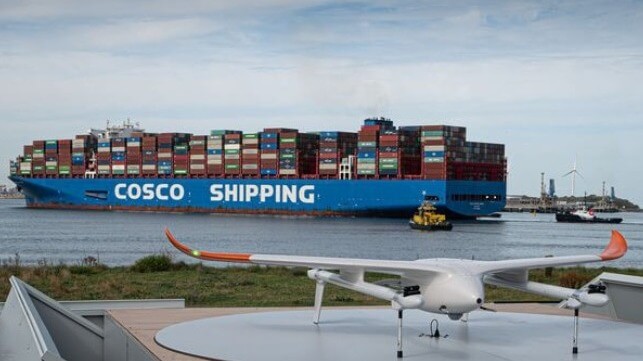Rotterdam Tests Drones for Ship Inspections and Monitoring the Port

The Port of Rotterdam, one of the busiest seaports in the world, is the latest to test drones for a range of inspection and monitoring tasks. The Port Authority reports it will be testing the drones for the next few months near Europoort and the western Maasvlakte extension which includes container and break-bulk terminals.
The Port of Rotterdam Authority says it wants to find out if the drones are suitable for supporting inspectors and shipping masters in their work. The trials are focused on sea-going and inland shipping inspections by the Harbor Master’s Division on bunkering, water pollution, ship-to-ship transfer, zoning for hazardous substances, shore-to-ship transfer, air pollution (smoke or soot), and repairs on board vessels.
The port selected the newest model of drones from Dutch manufacturer Avy, the Aera 3, for the tests. The drone has a wing span of approximately eight feet, a cruise speed of approximately 55 miles per hour, and an approximately 60-mile range at low energy consumption. The Port Authority says that two or three drones would suffice to cover the entire port area
The primary task for the drones will be monitoring activity in the port. The Port Authority reports for example, “if the drone detects an open tank filler cap, this might be an indication of illegal degassing by the vessel.” They would then be able to follow up with the specific ship to ensure that it is following the regulations.
Among the other tasks that they believe the drones would be suited for is monitoring during an incident in the port. They would be able to quickly have a drone over the area to see what was happening and monitor the response. The drone can also carry small cargoes of up to 3 kilos, such as refrigerated medical supplies, vessel parts, or cargo samples, facilitating the transfer of such items in the port.
The drones will take off automatically from a docking station installed at the Rotterdam-Rijnmond Pilotage Service at Pistoolhaven. The drones and helicopters will share the same airspace, so there should be clear rules in place as to how this airspace is used. Piloting, search and rescue operations conducted with the helicopters will always have priority over drone operations. They are also planning regular briefings with the helicopter pilots, who are also stationed on the Pilotage Service site, on days when the drones will be operating.
Drones have become increasingly common for a variety of maritime monitoring operations. The European Maritime Safety Agency (EMSA) is making drones available for a range of tasks including monitoring and testing emissions from ships operating in restricted areas well as coordinating with coast guards for safety and rescue operations. The Port of Antwerp has also been testing drones to monitor activity and maintain safety across the port complex. They explored the use of drones in various situations including infrastructure inspection, surveillance and monitoring, incident management, berth management, and oil spill or drift detection. Earlier this year, Antwerp tested drones to monitor the waters in the port looking for floating debris to speed the clean-up of the harbor to reduce the chances of damage to ships from floating debris.
